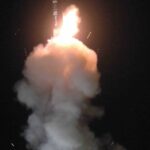
by Ajai Shukla
Unsigned editorial, Defence News of India
20th Nov 24
On Sunday, India announced that the Defence Research and Development Organisation (DRDO) had successfully test-flown a long-range, hypersonic missile that all three services can use to strike targets up to 1,500 kilometres away. Any contemporary list of cutting-edge military technologies has hypersonic, air-breathing, scramjet missiles close to the very top. Only three countries – Russia, USA and China – have flown vehicles in the atmosphere at hypersonic speeds: six times the speed of sound (Mach 6), or two kilometres (km) per second. After three decades of technological effort, India is poised to join that elite group.
Delivering a missile at hypersonic speed endows it with enormous military advantages. Most contemporary cruise missiles fly to their targets at sub-sonic speeds of 250-300 metres per second. Their low travelling speed renders them vulnerable to interception by the enemy’s supersonic fighter jets before they strike their targets. In contrast, hypersonic cruise missiles, by simply flying faster than the enemy’s fighter interceptors and missiles, reach their targets before they can be intercepted. Furthermore, the targets are left with insufficient time to change their profiles by, say, moving to protected shelters. In ground operations, hypersonic transport aircraft would enable army units to reinforce threatened theatres far more quickly. To illustrate, if positions in Ladakh were coming under threat, reinforcements from Thiruvananthapuram would require just half an hour of flying time to reach Leh. Finally, the kinetic impact of a missile travelling at Mach 6 would utterly demolish the target.
Despite the critical advantages that would accrue from a fleet of hypersonic aircraft and missiles, it has taken the DRDO almost 30 years to develop and test-fly a preliminary hypersonic missile at its flagship missile laboratory – the Defence R&D Laboratory (DRDL), Hyderabad. Scientists there explain that hypersonic flight presents two primary technological challenges. First, a hypersonic engine benefits from not having to carry its own oxygen, since it travels within the atmosphere where oxygen is freely available. All that the hypersonic engine carries is its fuel, which burns in combination with the atmospheric oxygen that is rammed into the engine at high supersonic speeds. That is why the engine is called a supersonic ramjet, or “scramjet” engine. However, it is a challenge to simultaneously inject fuel, combine it with the supersonic blast of air, and burn the mixture without the flame being extinguished by the air blast. Scientists liken this to “lighting a candle in a hurricane and keeping the flame alight.”
The second technological challenge is to cool the hypersonic missile’s outer skin, which gets red hot due to the friction between the atmosphere and the hypersonic aircraft travelling through it at Mach 6. To manage this, the missile’s skin is made of alloys, such as Niobium and Hafnium, which can withstand extreme temperatures. In addition, fluid is circulated under the hypersonic vehicle’s skin to dissipate the heat.
These are all high-tech processes involving rare materials and even the most advanced countries are struggling to master their peculiarities. The Americans, Chinese, Russians and French have demonstrated hypersonic flight for no more than a few seconds. India is still working on a 20-30 second programme. However, even as missiles become the weapons of the weak, air and missile defences become hot sellers. Saudi Arabia is buying the American THAAD and PAC-3; while India and Turkey buy the Russian S400. Hypersonic flight technologies underpin all these systems.






